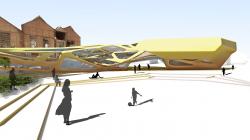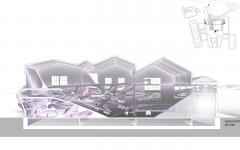non-program is a non-programmatic structure in and outside of an old factory building in izmir turkey. instead of establishing a program of function, the project constitutes a program and mix of different atmospheres, which are reacting on different senses of the human body.
the project generates a parallel universe in the city structure, space of fusion, where the ruin transforms itself to the city and the city to the ruin. the structure lets the user find its own body and space relationship.
to drift, getting lost in architecture is the essential point of the project. discovering new attractions, new points, new activities in the structure.
the mobility of architecture, based on modular elements, used in the projects of ‘60s was necessary at that time because of monotonous geometry of the elements. the combination of the elements, even one can decide for himself how to locate them, had converted the space frame structure to a boring whole. without the mobility of the elements, the created space was not complex and was easy to discover. only the mobile elements and ever changing character of the structure rescued the architecture from monotony and made it to something to discover. however as we see in the only realized project, pompidou, the mobile elements, which were designed to enable different space configurations, are rarely used. nowadays this can be done through projections, atmospheric effects. if these possibilities of change are not in active use, if the structure remains as it is, the difference between these projects and the existing city is questionable.
i want to point out that it is not the mobility of the elements but the complex geometry of this structure transforms the structure to a space of continuous discovery. the use of different architectural elements and different possibilities of connections, the loss and the impossibility of the orientation makes architectural space a place of continuous discovery.
there is no beginning and no end; else there are possibilities of different beginnings and ends. the state of confusion, the psychological effects that architecture can generate is my point of research.
to affect on the human psychology, to force him for the discovery, the functional typology should be subtracted from the architecture. typology defines the limits of use. if the use is limited, the state of confusion gets lost. so the functional typologies should be subtracted from architecture to generate the confusion. instead the atmospheres, the atmospheric effects should be defined. different atmospheres dismantle different reactions on the user. so each one can find his own attraction in this space, each one can define and redefine it continuously.
the reuse of the ruin
there are many projects, which are operating with old industrial ruins to reuse them as a museum or a nightclub or else. many times, ruin is renovated or reconstructed. the state of decay gets d, the building stands there as a whole (not as a part of this perfect whole anymore) like it was at the beginning. the long story of the ruin is often wiped out by the reconstruction. there is a whole new building added in the city structure instead. the ruin is d, everything is forgotten. the human intellect wins against the nature again.
however in my point of view, working on the ruin means working ‘with’ it. my aim is to create a connection between the ruin and today, leaving the ruin in the state of decay. every hole at the façade, every broken window, which connect the ruin a whole, have their own history. keeping the ruin as it is and transforming it not only to an of fascination as in romantic landscapes, even more to a place to be explored and re-discovered is one of the essential points in the project.
the solid structure situated on the busy street acts like the rabbit hole in alice in wonderland. the windowless concrete building with its soft surfaces is isolated from all noises around and inside.
athmospheres
the solid façade dissolves into a skeleton from which a gloomy light enters. a full scale of light cannot make it through as the top is still closed.
if one can move forward, the whole movement changes like a punch on the face. the straight forward way transforms itself to a web of different ramps and junctions. the structure becomes more transparent. there are dozens of people moving around, from one point to another. the eyes are activated to observe the happening, the movement. the junctions are collective points with installed led screens, which show the happenings on different parts of the complex or just act as lightning elements and generate atmospheric effects. the static structure flows into the ramps. the ramps become structure and later façade. there is no distinction, everything is a fluid whole. from here one can be directed to two different sectors.
inside the ruin, the air becomes cooler because of the natural air condition achieved through the huge water canals under the ruin reaching to the sea. the sea water cools the interior from below and the brick stone keeps this cool air inside. in this area the space becomes more dark and tight if one walks into the labyrinth in the ruin. the ramps are not wide enough for one person to walk in this sector not the eyes, but the ears are activated. one walks through unknown, hears the echoes of the other persons. the movement is controlled by the noises. this labyrinth is full of surprises. the tight ways open to hidden rooms, where one can find his own privacy. sometimes there is a grid instead of solid walls, so one can observe the movement of the others. some holes in the structure generate a view into the other dimension, the big hall behind the ramps. one becomes an observer of the happening but cannot join it. first the way, the exit should be discovered.
in the bridge leading to the second ruin, the highway is overgrown and open space without glazing. the nature growing from the garden below flows into the structure generates a mixture of urban environment and nature. one walks through a jungle in the urban atmosphere and feels the cool breeze coming from the sea, smells the salty air in a mix with the smell of the plants.
2009
2010
Zeynep Aksoz
Favorited 1 times
.jpg)
.jpg)






.jpg)
.jpg)
